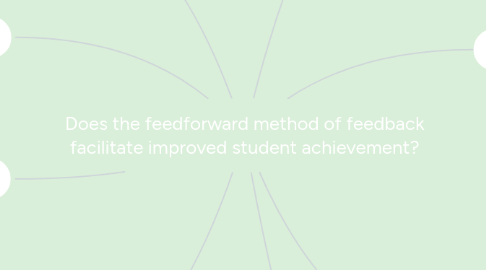
1. 2. Method Overview
1.1. Quantitative
1.1.1. Assessment results on assessment with the same objectives and rubric
1.1.1.1. Before
1.1.1.2. After
1.1.2. Survey on perceived influences/effectiveness
1.1.2.1. Student
1.1.2.2. Teacher
1.2. Qualitative
1.2.1. Assessed student work examples
1.2.1.1. looking for evidence of feedback present in subsequent assessments
1.2.2. Class observations of the process of receiving the feedback
1.2.2.1. Provide insight into engagement to the task and implementation
2. 1. Methodology Overview
2.1. Post-positivist
2.1.1. Follow the scientific method
2.1.1.1. Ratio: Quantitative > Qualitative
2.1.2. Reasoning is much of the current research regarding the topic is quantitative (Hattie)
3. 3. Research Site
3.1. International School
3.2. International Baccalaureate Programme
3.3. Culturally diverse student body
3.4. School size ~750 students
3.5. Students perform around the World Average on external assessments consistently with a normal distribution of results
4. 4. Research Participants
4.1. Science Department
4.2. MYP and DP Students (G6-12)
4.3. Three sections of each grade separated into Control, Focus and Wild Group. Groups are ~14 students each
4.3.1. Focus group has feedback that focuses on specific improvements
4.3.2. Control group is feedback given is based on what was incorrect in work
4.3.3. Wild Group will have no specific instructions on how feedback is given. (purpose is to normalize for general student growth during a year)
4.4. Students will not have to do anything different than what they would normally do between summative. Teachers will need to alter how they provide feedback to students.
4.4.1. Students and teachers will complete surveys after the second assessment to gauge their perceived impact of the feedback style
5. Ethics
5.1. Need to anonymize student work
5.1.1. Randomly number students so that names are protected but comparisons are still possible
5.2. Ensure that student growth is not hindered. Due to research by Hattie, any feedback is considered beneficial therefore the Control Group will not be hindered.
5.3. Students and Parents need to be made aware of the study
5.4. Categories the classes are assigned to need to be kept blind
6. 5. Data Analysis
6.1. ANOVA test to identify if one of the groups had a statistical different mean of improvement than other groups
6.2. T-test to compare difference of statistical means of two different test categories
6.2.1. p=0.05
6.3. Confidence intervals and standard deviation to identify range of data
6.4. Survey tallied and averages graphed
6.5. Qualitative data observations are provided in narrative fashion
7. 6.Evaluate Data
7.1. Compare results to previously published literature
7.2. Identify the range of results for reliability of data
7.3. Reflect on the effectiveness of the survey
7.4. As the assessments will not be identical pre and post. Examine that controls were effectively placed to ensure the assessment objectives were identical and authentically assessed by the rubric
7.5. Possible Limitations
7.5.1. Sample Size is small
7.5.2. very subject specific, further extensions to more subjects required
7.5.3. due to transient nature of international students, difficult to control prior knowledge and familiarity with curriculum (MYP/DP)
7.5.4. Teacher engagement and comfort with different feedback methods
